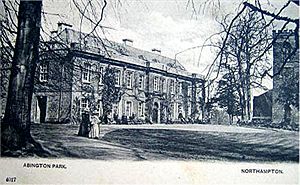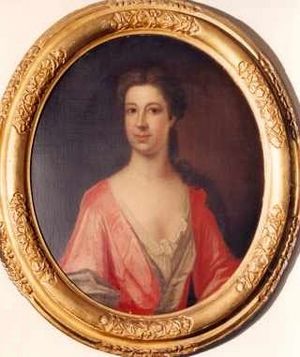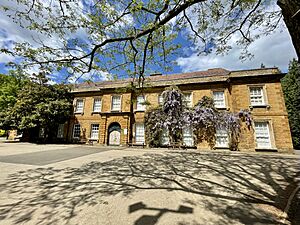Abington Park facts for kids

Edwardian postcard of Abington Manor with the church of St Peter and St Paul on the right
|
|
| Lua error in Module:Location_map at line 420: attempt to index field 'wikibase' (a nil value). | |
| Established | 1897 |
|---|---|
| Location | Abington, Northampton |
Abington Park is a wonderful green space located in the Abington area of Northampton, England. It's a popular spot with beautiful lakes, a museum, and open grassy areas perfect for playing or relaxing. You can also find aviaries with birds and many different kinds of trees here.
Contents
A Look Back: The Park's History
Abington Park holds a lot of history! It was once the site of a medieval village called Abington. This village had a manor house and a mill, and it was even mentioned in the Domesday Book in 1086. The Domesday Book was a huge survey ordered by William the Conqueror to record land and property in England.
Later, in the late 1600s, the Thursby family took over the manor. They made the manor house much bigger and created the large parklands you see today. Because of this, the old village of Abington was cleared away.
Abington Park Manor House: A Museum's Story
The museum in Abington Park is actually a very old manor house. It was first built around the year 1500. The oldest part of the house is called the Oak Room today because of its beautiful oak wood panels.
This historic house was once home to Elizabeth Barnard, who was the granddaughter of the famous playwright William Shakespeare. She lived there in the mid-1600s and was buried in 1670 at the nearby church of St Peter and St Paul. Her second husband, Sir John Bernard, 2nd Baronet, who was a Member of Parliament, made the house even larger in the 1660s.
The Thursby family owned the house from 1669. They continued to expand and update it between 1738 and 1743, giving it a classic Georgian style. A famous actor named David Garrick even planted a mulberry tree in the grounds in 1778, showing his friendship with Anne Thursby.
In 1821, a big storm damaged the church next to the house. The Thursbys helped rebuild most of the church, so it looks quite different from its original design.
From Home to Hospital to Museum
In 1841, the manor house was sold, and its contents were auctioned off. A few years later, in 1845, it was turned into a private hospital called Abington Abbey Retreat. This hospital helped people with mental health conditions. It closed in 1892.
After that, the Manor House and its grounds were given to the Northampton Council. In 1994, after a lot of restoration work, the house reopened as a museum!
The museum now has interesting exhibits about the history of Northamptonshire. You can see a collection of old costumes and learn about the area's military history, including items from the Northamptonshire Regiment. For a while, the Museum of Leathercraft was also located here, but it moved to a new spot in Northampton in 2016.
Exploring the Park Today
Abington Park is a fantastic place for everyone to enjoy. It has a special bandstand where you can listen to different kinds of music, like brass bands, concert bands, folk, or jazz. The park used to host a yearly 'Folk in the Park' festival, which is now held at Delapré Abbey.
The park also features two lovely lakes and a smaller lake for model boats, all connected by a stream. The largest lake was redesigned in the 1920s. Besides the water, there's a fun play park for kids, a cafe for snacks, tennis courts, and even outdoor table tennis. You can also relax in the beautiful rose garden or visit the historic church of St Peter and St Paul.




